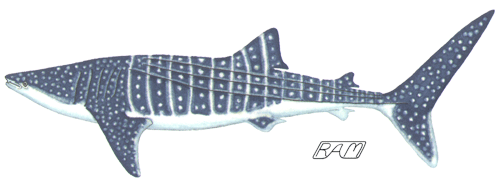Rhincodon or Rhiniodon?
A Whale Shark by any Other Name

On 4 June 2002, a question came across my desktop from a student with whom I had corresponded sporadically on matters chondrichthyan for more than a year:
Which is correct for the Whale Shark, Rhincodon typus or Rhiniodon typus?
Hamlett (1999) uses both, but list them in separate
areas and does not mention that one may be outdated.
On page 6: "In filter-feeding elasmobranchs (whale shark, Rhincodon
typus;....."
On page 54: ..."the giant whale shark, Rhiniodon typus, and the
large..."
Have I missed something and now there are two, a regular and a large?
The other books I have use Rhincodon... which is correct?
- Barbara
Barbara:
The correct name is Rhincodon typus Smith, 1829.
British surgeon and naturalist Andrew Smith described the first specimen of Whale Shark from Table Bay, South Africa, in 1828. He originally named it Rhiniodon typus. The 4.6-m (15-ft) male holotype was mounted, stuffed, and curated at the Natural History Museum in Paris. But Smith also used the names Rhincodon typus and Rhineodon typus in separate publications in 1829. German anatomists Muller and Henle used the name Rhinodon typicus in 1839. So which name is correct?
In general, the earliest published name has priority. In this case, the earliest published name is clearly Rhiniodon typus. Chondrichthyan taxonomist Leonard Compagno knew this and used Rhiniodon typus as his preferred name in his widely-used FAO Species Catalogue, Sharks of the World (1984). Many people followed Compagno without question. Compagno is widely regarded as THE world expert on all matters of chondrichthyan taxonomy and systematics. But it is always dangerous to accept any 'expert' decree without question.
A closer look at the original literature reveals what happened. Smith's original description appeared in a very obscure periodical, The South African Commercial Advertiser. This is not, by any stretch of the imagination, a peer-reviewed scientific publication. Nor was it widely available to the international scientific community. So, a year later, Smith published a more lengthy description of the same specimen in Zoology Journal, but this time he used the name Rhincodon typus. This is the name that most researchers have used ever since.
Since Smith's 1829 description in Zoology Journal constituted formal "publication" under the definition stipulated by the International Commission on Zoological Nomenclature (ICZN) and most researchers were using the name Rhincodon typus anyway, this is the name decreed by the ICZN in 1984 (Opinion 1278) to be the "correct" scientific name to be used for the Whale Shark.
And that, as they say, is The Rest of The Story ...
Cheers,
— R. Aidan Martin
